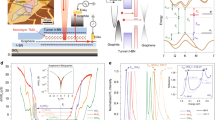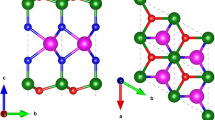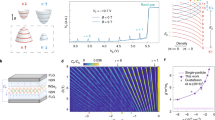Abstract
Two-dimensional (2D) transition metal dichalcogenides (TMDs) are emerging as a new platform for exploring 2D semiconductor physics1,2,3,4,5,6,7,8,9. Reduced screening in two dimensions results in markedly enhanced electron–electron interactions, which have been predicted to generate giant bandgap renormalization and excitonic effects10,11,12,13. Here we present a rigorous experimental observation of extraordinarily large exciton binding energy in a 2D semiconducting TMD. We determine the single-particle electronic bandgap of single-layer MoSe2 by means of scanning tunnelling spectroscopy (STS), as well as the two-particle exciton transition energy using photoluminescence (PL) spectroscopy. These yield an exciton binding energy of 0.55 eV for monolayer MoSe2 on graphene—orders of magnitude larger than what is seen in conventional 3D semiconductors and significantly higher than what we see for MoSe2 monolayers in more highly screening environments. This finding is corroborated by our ab initio GW and Bethe–Salpeter equation calculations14,15 which include electron correlation effects. The renormalized bandgap and large exciton binding observed here will have a profound impact on electronic and optoelectronic device technologies based on single-layer semiconducting TMDs.
This is a preview of subscription content, access via your institution
Access options
Subscribe to this journal
Receive 12 print issues and online access
$259.00 per year
only $21.58 per issue
Buy this article
- Purchase on Springer Link
- Instant access to full article PDF
Prices may be subject to local taxes which are calculated during checkout




Similar content being viewed by others
References
Mak, K. F. et al. Atomically thin MoS2: A new direct-gap semiconductor. Phys. Rev. Lett. 105, 136805 (2010).
Splendiani, A. et al. Emerging photoluminescence in monolayer MoS2 . Nano Lett. 10, 1271–1275 (2010).
Mak, K. F., He, K. L., Shan, J. & Heinz, T. F. Control of valley polarization in monolayer MoS2 by optical helicity. Nature Nanotech. 7, 494–498 (2012).
Zeng, H. L. et al. Valley polarization in MoS2 monolayers by optical pumping. Nature Nanotech. 7, 490–493 (2012).
Cao, T. et al. Valley-selective circular dichroism of monolayer molybdenum disulphide. Nature Commun. 3, 1882 (2012).
Jones, A. M. et al. Optical generation of excitonic valley coherence in monolayer WSe2 . Nature Nanotech. 8, 634–638 (2013).
Britnell, L. et al. Strong light–matter interactions in heterostructures of atomically thin films. Science 340, 1311–1314 (2013).
Mak, K. F. et al. Tightly bound trions in monolayer MoS2 . Nature Mater. 12, 207–211 (2013).
Zhang, Y. et al. Direct observation of the transition from indirect to direct band gap in atomically-thin epitaxial MoSe2 . Nature Nanotech. 9, 111–115 (2014).
Cheiwchanchamnangij, T. & Lambrecht, W. R. L. Quasiparticle band structure calculation of monolayer, bilayer, and bulk MoS2 . Phys. Rev. B 85, 205302 (2012).
Ramasubramaniam, A. Large excitonic effects in monolayers of molybdenum and tungsten dichalcogenides. Phys. Rev. B 86, 115409 (2012).
Komsa, H. P. & Krasheninnikov, A. V. Effects of confinement and environment on the electronic structure and exciton binding energy of MoS2 from first principles. Phys. Rev. B 86, 241201 (2012).
Qiu, D. Y., da Jornada, F. H. & Louie, S. G. Optical spectrum of MoS2: Many-body effects and diversity of exciton states. Phys. Rev. Lett. 111, 216805 (2013).
Hybertsen, M. S. & Louie, S. G. Electron correlation in semiconductors and insulators: band-gaps and quasi-particle energies. Phys. Rev. B 34, 5390–5413 (1986).
Rohlfing, M. & Louie, S. G. Electron–hole excitations and optical spectra from first principles. Phys. Rev. B 62, 4927–4944 (2000).
Radisavljevic, B., Radenovic, A., Brivio, J., Giacometti, V. & Kis, A. Single-layer MoS2 transistors. Nature Nanotech. 6, 147–150 (2011).
Bernardi, M., Palummo, M. & Grossman, J. C. Extraordinary sunlight absorption and one nanometer thick photovoltaics using two-dimensional monolayer materials. Nano Lett. 13, 3664–3670 (2013).
Gutierrez, H. R. et al. Extraordinary room-temperature photoluminescence in triangular WS2 monolayers. Nano Lett. 13, 3447–3454 (2013).
Wang, F., Dukovic, G., Brus, L. E. & Heinz, T. F. The optical resonances in carbon nanotubes arise from excitons. Science 308, 838–841 (2005).
Scholes, G. D. & Rumbles, G. Excitons in nanoscale systems. Nature Mater. 5, 683–696 (2006).
Mallet, P. et al. Electron states of mono- and bilayer graphene on SiC probed by scanning-tunneling microscopy. Phys. Rev. B 76, 041403 (2007).
Hor, Y. S. et al. p-type Bi2Se3 for topological insulator and low-temperature thermoelectric applications. Phys. Rev. B 79, 195208 (2009).
Feenstra, R. M. & Stroscio, J. A. Tunneling spectroscopy of the GaAs(110) surface. J. Vac. Sci. Technol. B 5, 923–929 (1987).
Ross, J. S. et al. Electrical control of neutral and charged excitons in a monolayer semiconductor. Nature Commun. 4, 2498 (2013).
Deslippe, J. et al. BerkeleyGW: A massively parallel computer package for the calculation of the quasiparticle and optical properties of materials and nanostructures. Comput. Phys. Commun. 183, 1269–1289 (2012).
Lischner, J., Vigil-Fowler, D. & Louie, S. G. Physical origin of satellites in photoemission of doped graphene: An ab Initio GW plus cumulant study. Phys. Rev. Lett. 110, 146801 (2013).
Helveg, S. et al. Atomic-scale structure of single-layer MoS2 nanoclusters. Phys. Rev. Lett. 84, 951–954 (2000).
Zhang, C. et al. Direct imaging of band profile in single layer MoS2 on graphite: Quasiparticle energy gap, metallic edge states, and edge band bending. Nano Lett. 14, 2443–2447 (2014).
Brar, V. W. et al. Scanning tunneling spectroscopy of inhomogeneous electronic structure in monolayer and bilayer graphene on SiC. Appl. Phys. Lett. 91, 122102 (2007).
Mallet, P. et al. Role of pseudospin in quasiparticle interferences in epitaxial graphene probed by high-resolution scanning tunneling microscopy. Phys. Rev. B 86, 045444 (2012).
Horcas, I. et al. WSXM: A software for scanning probe microscopy and a tool for nanotechnology. Rev. Sci. Instrum. 78, 013705 (2007).
Acknowledgements
Research supported by Office of Basic Energy Sciences, Department of Energy Early Career Award No. DE-SC0003949 (optical measurements), and by the sp2 Program (STM instrumentation development and operation), the Theory Program (GW–BSE calculations), and the SciDAC Program on Excited State Phenomena in Energy Materials (algorithms and codes) which are funded by the US Department of Energy, Office of Basic Energy Sciences and of Advanced Scientific Computing Research, under Contract No. DE-AC02-05CH11231. Support also provided by National Science Foundation award no. 1235361 (image analysis) and National Science Foundation award no. DMR10-1006184 (substrate screening theory and calculations). Computational resources have been provided by the NSF through XSEDE resources at NICS and DOE at NERSC. A.J.B. was supported by the Department of Defense (DoD) through the National Defense Science & Engineering Graduate Fellowship (NDSEG) Program. W. R acknowledges support from the Chinese Scholarship Council (No. 201306210202). D.Y.Q. acknowledges support from NSF Graduate Research Fellowship Grant No. DGE 1106400 and S.G.L. acknowledges support of a Simons Foundation Fellowship in Theoretical Physics. STM/STS data were analysed and rendered using WSxM software31. S-F.S. and F.W. acknowledge X. Hong and J. Kim for technical help.
Author information
Authors and Affiliations
Contributions
M.M.U., A.J.B., S-F.S., F.W. and M.F.C. conceived the work and designed the research strategy. M.M.U. and A.J.B. measured and analysed the STM/STS data in collaboration with W.R. for the MoSe2/HOPG experiments. S-F.S. carried out the photoluminescence and Raman experiments. F.H.d.J. and D.Y.Q. performed the theoretical calculations. Y.Z. and S-K.M. performed the MBE growth and characterization (LEED, RHEED, core-level spectroscopy) of the samples. Z.H. and Z-X.S. supervised the MBE and sample characterization. F.W. supervised the optical measurements. S.G.L. supervised the theoretical calculations. M.F.C. supervised the STM/STS experiments. M.M.U. wrote the paper with help from A.J.B. and M.F.C. M.M.U. and M.F.C. coordinated the collaboration. All authors contributed to the scientific discussion and manuscript revisions.
Corresponding authors
Ethics declarations
Competing interests
The authors declare no competing financial interests.
Supplementary information
Supplementary Information
Supplementary Information (PDF 3748 kb)
Rights and permissions
About this article
Cite this article
Ugeda, M., Bradley, A., Shi, SF. et al. Giant bandgap renormalization and excitonic effects in a monolayer transition metal dichalcogenide semiconductor. Nature Mater 13, 1091–1095 (2014). https://doi.org/10.1038/nmat4061
Received:
Accepted:
Published:
Issue Date:
DOI: https://doi.org/10.1038/nmat4061
This article is cited by
-
Ultra-compact exciton polariton modulator based on van der Waals semiconductors
Nature Communications (2024)
-
Vapour-phase deposition of two-dimensional layered chalcogenides
Nature Reviews Materials (2023)
-
Exciton fine structure in twisted transition metal dichalcogenide heterostructures
npj Computational Materials (2023)
-
Observation of ~100% valley-coherent excitons in monolayer MoS2 through giant enhancement of valley coherence time
Light: Science & Applications (2023)
-
pyGWBSE: a high throughput workflow package for GW-BSE calculations
npj Computational Materials (2023)



